Top Winter Treks in India 2025: Easy to Extreme
Winter in India brings with it a magical transformation of landscapes, turning rugged mountains and valleys into snow-blanketed wonderlands. For trekking enthusiasts, winter treks in India offer an unmatched adventure filled with breathtaking views, challenging trails, and unforgettable memories. Whether you are a beginner or an experienced trekker, these trails provide opportunities to witness the charm of frozen rivers, snow-laden forests, and Himalayan peaks glowing in the winter sun.
What makes winter treks in India truly special is their ability to blend adventure with serenity. Each trek not only tests endurance but also provides moments of peace in pristine environments far away from busy cities. The sense of achievement after conquering a snow trail and the warmth of local hospitality make these journeys rewarding for every traveller.
Why Choose Winter Treks in India?
When the Himalayas are draped in snow, trekking trails turn into paths of pure white bliss. Winter treks in India are known for their thrilling experiences, as trekkers navigate icy routes and frozen streams. Beyond the adventure, winter brings clearer skies, offering panoramic views of peaks such as Nanda Devi, Trishul, and Swargarohini. Unlike summer treks, these routes are less crowded, giving you a chance to enjoy solitude amidst pristine beauty.
Top Winter Treks in India: Easy to Extreme
This article highlights the best winter treks in India, catering to trekkers of all levels—from beginners to seasoned adventurers. It covers a range of trails offering unique experiences, such as snow-covered landscapes, frozen lakes, and panoramic Himalayan views. Each trek is described in detail, providing insights into difficulty levels, duration, and highlights, helping you choose the perfect winter adventure.
Kedarkantha Trek | Tungnath Trek | Dayara Bugyal Trek | Kuari Pass Trek | Brahmatal Trek | Sandakphu Trek | Chadar Trek
1. Kedarkantha Trek (Uttarakhand)
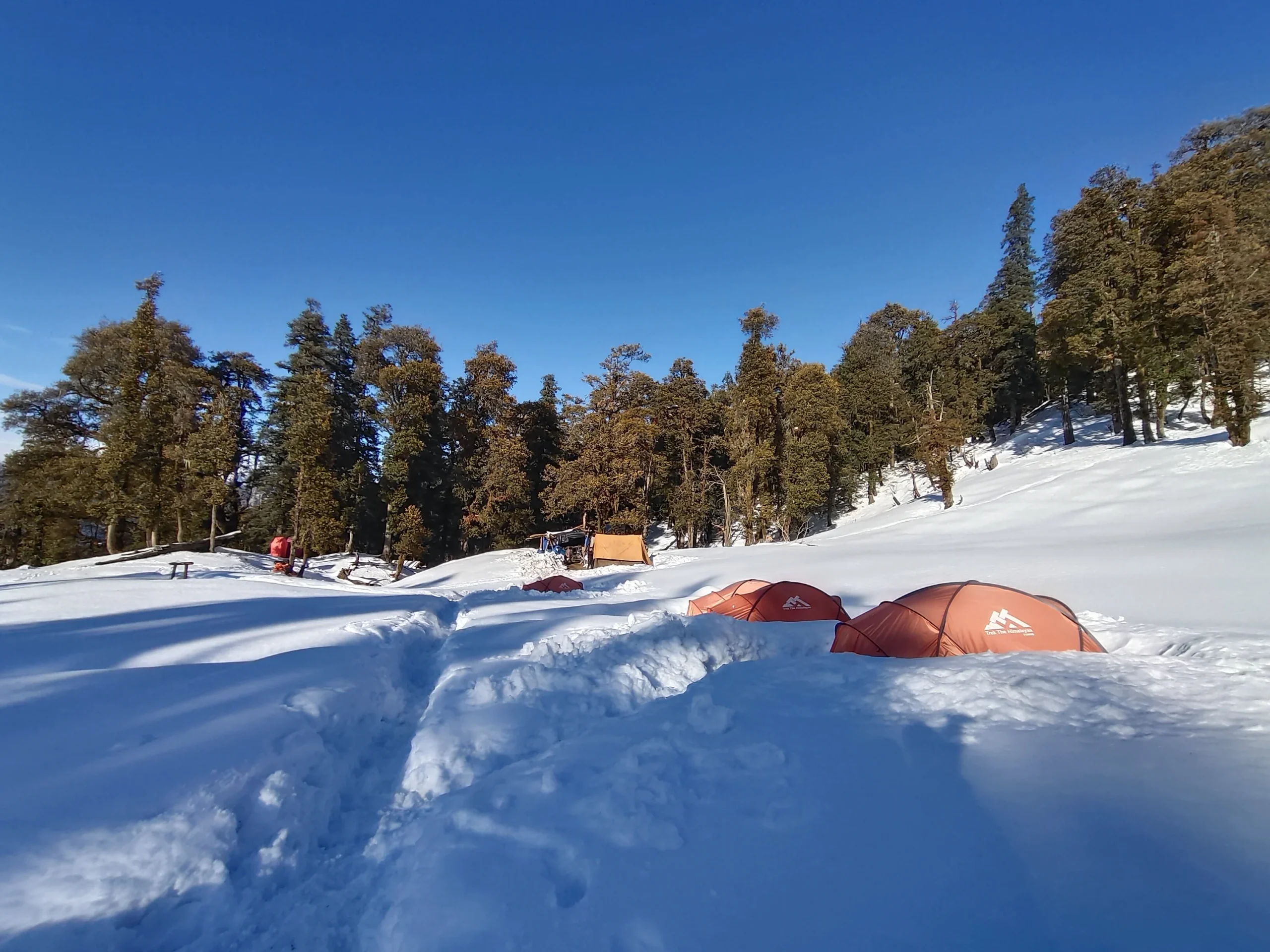
Overview:
Difficulty Level: Easy to Moderate
Adventure Type: Trekking Expedition
Maximum Altitude: 12,500 feet (3,810 meters)
Trek Distance: ~20 km
Duration: 5 Days / 4 Nights
Ideal Months: October – April
Best Seasons: Winter | Spring | Autumn
Base Camp: Sankri Village, Uttarkashi
Summary:
The Kedarkantha Trek is one of the most rewarding winter treks in India, perfect for both beginners and experienced trekkers. With an altitude of 12,500 ft. and covering nearly 20 km, this journey offers the right balance of adventure and comfort. Spread across 5 days and 4 nights, it takes you through snow-covered trails, dense pine forests, and breathtaking Himalayan views.
Starting from Sankri Village in Uttarkashi, this trek is best enjoyed between October and April, especially during the winter season. Known for its easy-to-moderate difficulty level, Kedarkantha is a favourite among those looking for scenic beauty, thrilling climbs, and unforgettable summit experiences. Truly, it’s a trail that captures the essence of the Himalayas.
2. Tungnath Trek (Uttarakhand)
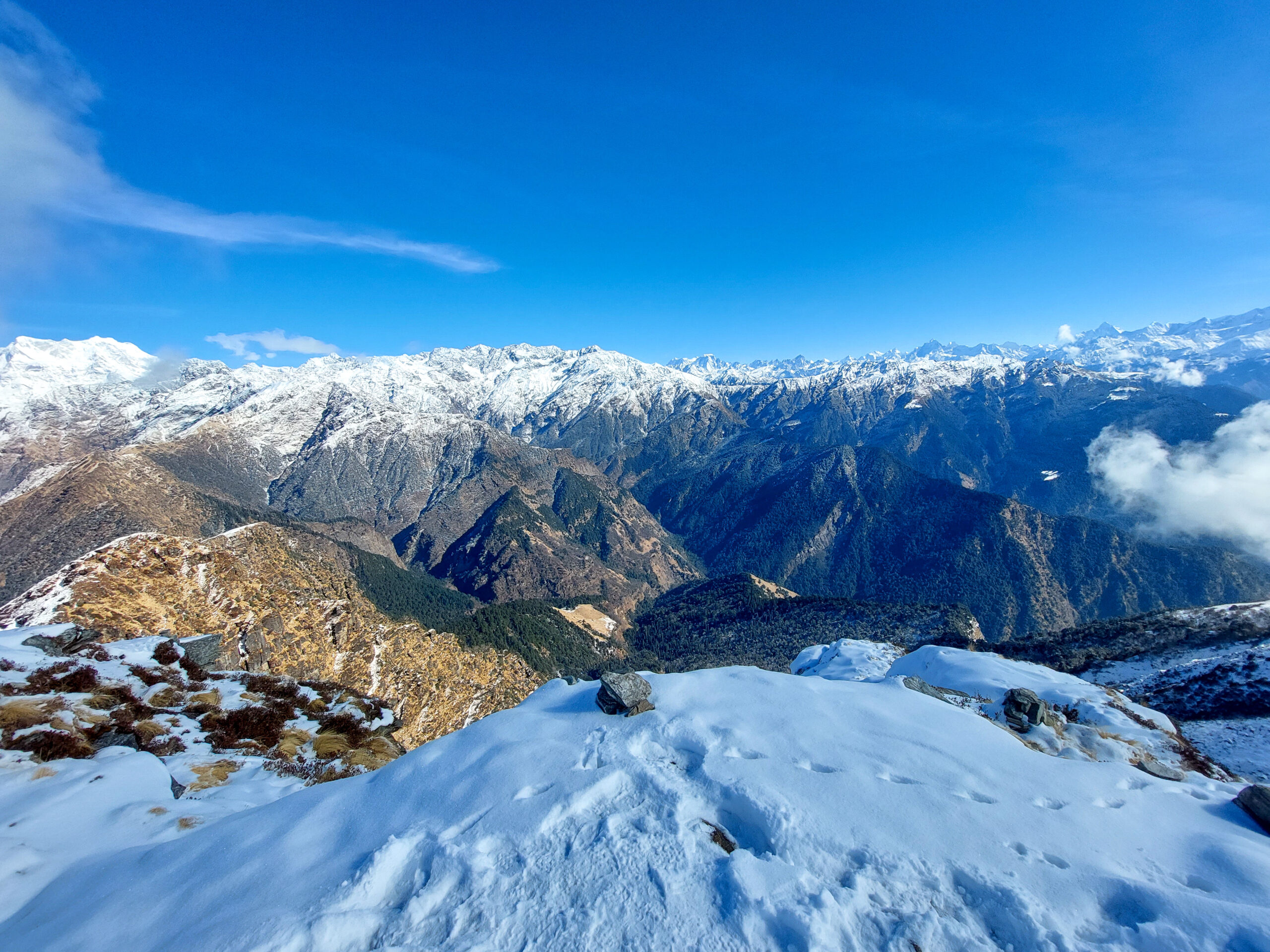
Overview:
Difficulty Level: Easy to Moderate
Adventure Type: Trekking Expedition
Maximum Altitude: 12,073 feet (3,680 meters)
Trek Distance: ~15 km
Duration: 4 Days / 3 Nights
Ideal Months: March – June | September – December
Best Seasons: Spring | Autumn | Winter
Base Camp: Chopta, Uttarakhand
Summary:
The Tungnath Trek is a scenic trail that combines natural beauty with spiritual significance, making it one of the most memorable Himalayan journeys. With an altitude of 12,100 ft. and a distance of around 15 km, it offers trekkers a mix of lush forests, meadows, and breathtaking mountain views across 4 days and 3 nights.
Starting from the picturesque base camp at Chopta, this trek is best enjoyed during the spring, autumn, or winter months. Known for its easy-to-moderate difficulty level, the Tungnath Trek also takes you to the highest Shiva temple in the world, adding a unique cultural touch to the adventure.
3. Dayara Bugyal Trek (Uttarakhand)
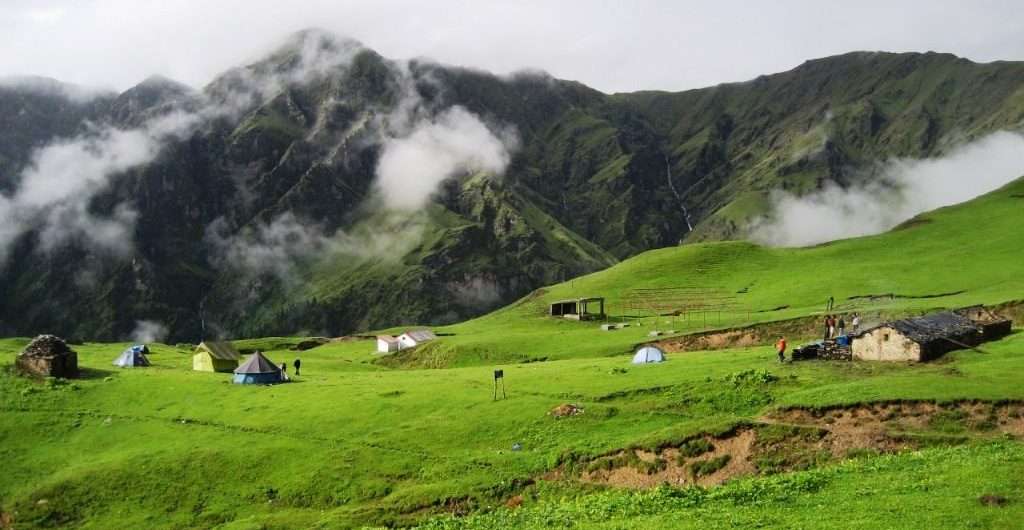
Overview:
Difficulty Level: Easy to Moderate
Adventure Type: Trekking Expedition
Maximum Altitude: 11,900 to 12,000 feet (around 3,658 meters)
Trek Distance: ~22 km
Duration: 6 Days / 5 Nights
Ideal Months: May – November | December – February
Best Seasons: Summer | Winter | Autumn
Base Camp: Barsu Village, Uttarkashi, Uttarakhand
Summary:
The Dayara Bugyal Trek is one of the most scenic winter treks in India, known for its vast alpine meadows stretching as far as the eye can see. At an altitude of 12,000 ft., this trek offers stunning views of snow-clad peaks like Bandarpoonch and Draupadi ka Danda, making it a perfect choice for both beginners and seasoned trekkers. With easy to moderate difficulty, it provides a balanced mix of adventure and natural beauty.
Spanning 22 km over 6 days, the trail takes you through ancient oak forests, peaceful villages, and wide open bugyals that change their charm with every season. Whether covered in a blanket of snow during winter or blooming with wildflowers in summer, the Dayara Bugyal Trek promises an unforgettable Himalayan experience that truly feels timeless.
4. Kuari Pass Trek (Uttarakhand)
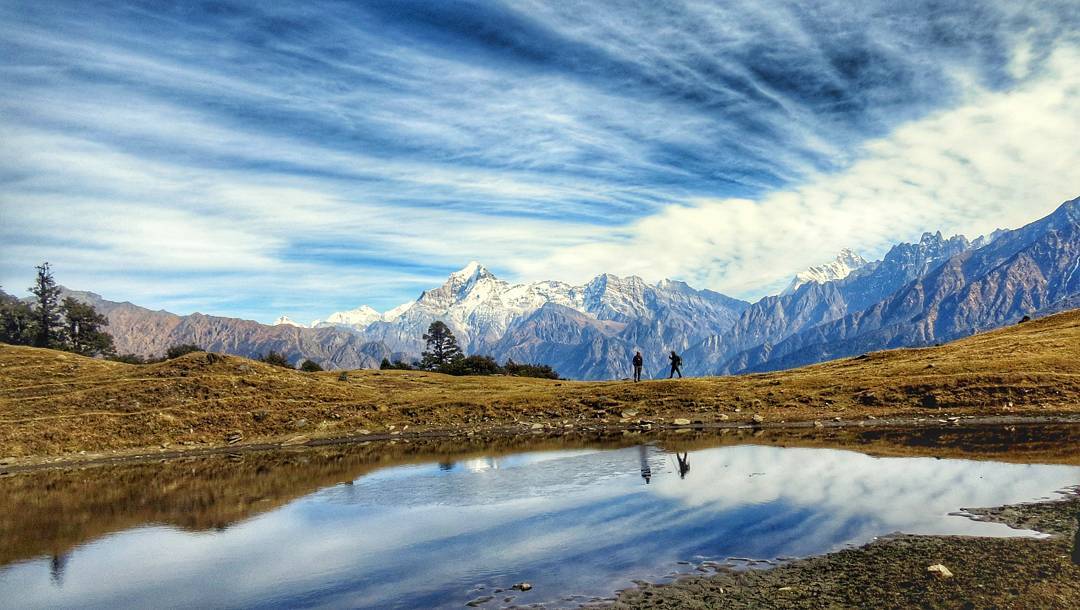
Overview:
Difficulty Level: Easy to Moderate
Adventure Type: Trekking Expedition
Maximum Altitude: 12,500 to 12,760 feet (3,815 to 3,890 meters)
Trek Distance: ~33 km
Duration: 6 Days / 5 Nights
Ideal Months: March – June | September – December
Best Seasons: Spring | Autumn | Winter
Base Camp: Joshimath, Uttarakhand
Summary:
The Kuari Pass Trek is a classic Himalayan journey that beautifully blends adventure with panoramic scenery. Known for its moderate difficulty, this trail takes trekkers through dense oak and rhododendron forests, open meadows, and charming mountain villages. With an altitude of 12,516 ft., it offers incredible views of snow-clad peaks like Nanda Devi, Dronagiri, and Kamet, making it one of the most rewarding winter treks in Uttarakhand.
Over 6 days and covering nearly 33 km, the Kuari Pass Trek strikes a perfect balance for both beginners and experienced trekkers. The trail allows adventurers to soak in the rich culture of the Garhwal region while enjoying breathtaking Himalayan landscapes. With its mix of natural beauty, cultural encounters, and manageable challenges, this trek is often regarded as a must-do for those looking to experience the true essence of the Indian Himalayas.
5. Brahmatal Trek (Uttarakhand)
Overview:
Difficulty Level: Easy to Moderate
Adventure Type: Trekking Expedition
Maximum Altitude: 12,250 feet (3,750 meters)
Trek Distance: ~22 km
Duration: 6 Days / 5 Nights
Ideal Months: December – March
Best Seasons: Winter | Early Spring
Base Camp: Lohajung, Uttarakhand
Summary:
The Brahmatal Trek is one of the most captivating winter treks in Uttarakhand, offering a unique blend of snow-covered trails, frozen lakes, and panoramic views of Himalayan giants like Mt. Trishul and Nanda Ghunti. Starting from Lohajung, the trek gradually takes you through oak and rhododendron forests that open up to vast snow meadows, making it a perfect choice for trekkers seeking both beauty and adventure.
What makes the Brahmatal Trek special is the chance to camp beside a high-altitude frozen lake and witness golden Himalayan sunrises from the ridge. At 12,150 ft., the summit rewards trekkers with sweeping 360-degree views, making the journey an unforgettable experience in the heart of the Garhwal Himalayas.
6. Sandakphu Trek (West Bengal / Sikkim)
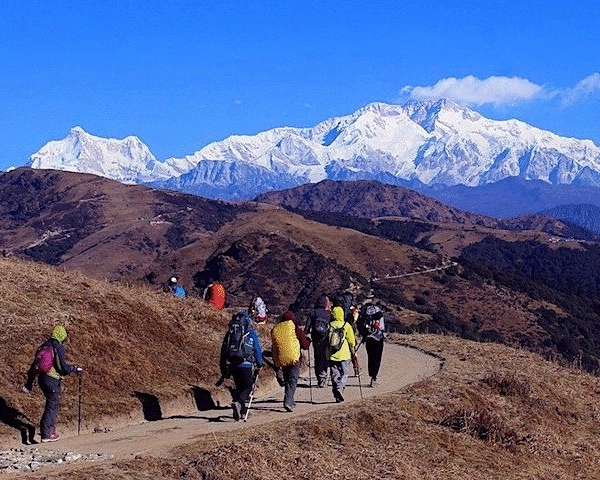
Overview:
Difficulty Level: Moderate
Adventure Type: Trekking Expedition
Maximum Altitude: 11,930 feet (3,636 meters)
Trek Distance: ~55 km
Duration: 8–10 Days / 9 Nights
Ideal Months: March – May | September – November
Best Seasons: Spring | Autumn
Base Camp: Manebhanjan, West Bengal
Summary:
The Sandakphu Trek is one of the most spectacular Himalayan treks, offering unparalleled panoramic views of four of the world’s highest peaks—Mount Everest, Kanchenjunga, Lhotse, and Makalu. The trek begins at Manebhanjan and takes you through lush forests, charming villages, and rolling rhododendron-covered hills, making it ideal for trekkers seeking both adventure and scenic beauty.
What makes the Sandakphu Trek truly special is the sunrise and sunset views from the Singalila Ridge, which offer a breathtaking 360-degree Himalayan panorama. Reaching the summit at 11,930 ft., trekkers are rewarded with awe-inspiring vistas and a serene high-altitude experience that lingers long after the journey ends.
7. Chadar Trek (Ladakh)
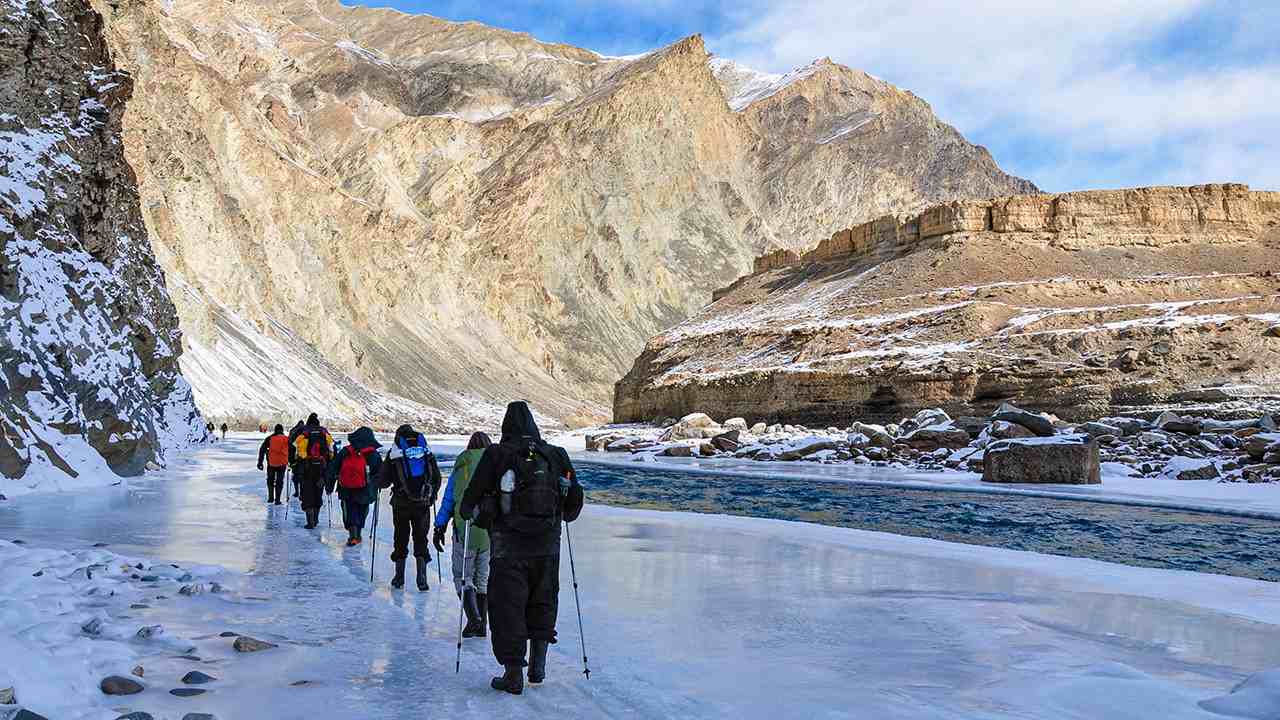
Overview:
Difficulty Level: Moderate to Difficult
Adventure Type: Winter Trek / Frozen River Expedition
Maximum Altitude: 12,500 feet (3,810 meters)
Trek Distance: ~62 km
Duration: 9 Days / 8 Nights
Ideal Months: January – February
Best Seasons: Winter
Base Camp: Leh, Ladakh
Summary:
The Chadar Trek in Ladakh is a unique winter adventure that takes you across the frozen Zanskar River, offering an experience like no other. Trekkers traverse vast stretches of ice, surrounded by towering cliffs and snow-covered mountains, making every step both thrilling and visually spectacular.
What makes the Chadar Trek truly extraordinary is walking on the frozen river itself, witnessing frozen waterfalls, and camping in high-altitude icy landscapes. At altitudes up to 12,500 ft., this trek is perfect for adventurers seeking an extreme, once-in-a-lifetime Himalayan experience in the heart of Ladakh.
Winter Treks in India for Experienced Trekkers
For those seeking a true adventure, winter treks in India for experienced trekkers offer some of the most challenging and rewarding routes in the Himalayas. Trails like the Chadar Trek, Brahmatal, and Har Ki Dun test both endurance and skill, providing trekkers with breathtaking landscapes of snow-laden forests, frozen rivers, and towering Himalayan peaks. These treks are perfect for adventurers who want to push their limits while enjoying the pristine beauty of winter in India.
Among the most iconic is the Chadar Trek, where trekkers navigate the frozen Zanskar River, experiencing the thrill of walking on ice at high altitudes. Brahmatal offers a mix of serene snow-covered meadows and panoramic views of Mount Trishul and Nanda Ghunti, while Har Ki Dun, the “Valley of Gods,” blends winter adventure with cultural and historical significance. Choosing any of these routes ensures an unforgettable experience for seasoned trekkers seeking the ultimate winter treks in India for experienced trekkers.
Unique Experiences on Winter Treks in India
One of the most captivating aspects of winter treks in India is the wide range of unique experiences they provide. Trekkers can camp under a starlit sky surrounded by pristine snow, traverse frozen rivers, and walk past sparkling ice waterfalls, creating memories that last a lifetime. The serene landscapes and untouched snow-covered trails make these treks truly magical for adventure enthusiasts and nature lovers alike.
Additionally, winter treks in India offer cultural encounters that are hard to find elsewhere. Interacting with local villagers in remote Himalayan regions allows trekkers to learn about traditional lifestyles, customs, and hospitality. Spotting rare wildlife, such as the Himalayan Monal or musk deer, along the trail adds another layer of wonder, making each journey a blend of adventure, nature, and cultural discovery.
Safety Tips for Winter Treks in India
While the allure of snow-covered peaks is irresistible, safety should always be a top priority on winter treks in India. Proper gear, including insulated boots, layered clothing, trekking poles, and sleeping bags rated for sub-zero temperatures, is essential to stay warm and protected against harsh conditions. Ensuring that you carry a well-stocked first aid kit and staying hydrated throughout the trek further enhances your safety and comfort.
Equally important is trekking with professional guides who are familiar with the routes and weather patterns. Being physically prepared with good stamina and strength is crucial to navigating icy paths, steep ascents, and high-altitude terrain. Following these safety measures ensures that your winter treks in India are not only adventurous but also safe, enjoyable, and memorable.
Best Time to Go for Winter Treks in India
The ideal period for winter treks in India generally starts in late December and continues until early March. January and February are considered peak months, offering the heaviest snowfall and creating stunning snow-clad landscapes that make trekking a magical experience. Trekkers during this time can enjoy pristine trails, frozen lakes, and breathtaking Himalayan vistas at their best.
For those who prefer slightly milder conditions, early December and late February are also suitable for winter treks in India. These months provide snow-covered scenery while avoiding the extreme cold of peak winter. Choosing the right time ensures both safety and enjoyment, allowing trekkers to fully experience the beauty and serenity of the Himalayan winter trails.
How to Prepare for Winter Treks in India
Proper preparation is crucial for a successful experience on winter treks in India. Building physical endurance through regular cardio exercises, strength training, and practice hikes with a loaded backpack ensures that trekkers can handle long trails, icy paths, and high-altitude challenges. Mental preparation is equally important, as winter trekking tests patience, resilience, and the ability to stay calm under extreme conditions.
Equipping yourself with lightweight yet effective gear, staying updated on weather forecasts, and trekking with reputable guides or organisations significantly enhances safety and comfort. Following these steps not only makes winter treks in India more manageable but also ensures a memorable and enjoyable adventure amidst snow-covered mountains and pristine Himalayan landscapes.
The Spiritual Side of Winter Treks in India
Many winter treks in India offer more than just thrilling adventure—they provide a journey of spiritual fulfilment. Treks like Har Ki Dun and Brahmatal are intertwined with Hindu mythology, allowing trekkers to experience sacred landscapes while walking through snow-laden forests and serene mountain trails. This combination of adventure and spirituality makes the trekking experience truly unique.
Walking through ancient villages and quiet meadows during winter treks in India often feels meditative, providing moments of reflection and inner peace. The tranquil environment, coupled with the pristine beauty of snow-covered Himalayas, enables trekkers to connect deeply with nature and themselves, making these treks not only physically rewarding but spiritually enriching as well.
Eco-Friendly Practices on Winter Treks in India
Sustainability plays a crucial role in winter treks in India, ensuring that the pristine Himalayan environment remains untouched for future adventurers. Trekkers should practice “leave no trace” principles by carrying back all plastic and non-biodegradable waste, avoiding unnecessary campfires, and being mindful of fragile ecosystems along the trails. Such responsible behaviour helps preserve snow-covered forests, frozen lakes, and alpine meadows.
Using reusable water bottles, eco-friendly trekking gear, and supporting local homestays are additional ways to make a positive impact during winter treks in India. Respecting local cultures, wildlife, and natural surroundings not only contributes to environmental conservation but also enriches the trekking experience, allowing adventurers to enjoy the Himalayas responsibly and sustainably.
Insider Tips for Choosing Your Trek
-
For beginners: Start with Kedarkantha, Brahmatal, or Dayara Bugyal. These offer scenic snow experiences without extreme altitudes or terrain.
-
For moderate adventurers: Try Kuari Pass or Sandakphu for equally beautiful routes with added flair.
-
For seasoned thrill-seekers: The Chadar Trek is unparalleled but requires full preparation, specialised gear, and extreme resilience.
-
Tailor your trek based on desired snow levels, crowd-season preference, and difficulty tolerance.
Conclusion
Exploring the winter treks in India opens a world of snow-carpeted trails, solitude, and Himalayan grandeur—from beginner-friendly routes like Dayara Bugyal to the ethereal yet demanding Chadar Trek. No matter your choice, each path promises a unique blend of beauty, challenge, and memories. For a truly seamless and immersive snow trek experience, entrust your journey to the best trekking company in India. Let BlissCamp India guide you toward your next winter adventure.
FAQs: Winter Treks in India
Que 1. What are the best winter treks in India for beginners?
Ans: For beginners, winter treks in India like Kedarkantha Trek, Brahmatal Trek, and Dayara Bugyal Trek are ideal. These treks offer manageable distances, moderate altitudes, and scenic snow-covered trails, making them perfect for first-time winter trekkers.
Que 2. Which winter trek in India is the most challenging?
Ans: The Chadar Trek in Ladakh is considered one of the most extreme winter treks in India. Walking over the frozen Zanskar River at altitudes above 12,500 ft., it requires physical endurance, proper gear, and experience with icy terrain.
Que 3. When is the best time to go on winter treks in India?
Ans: The best season for winter treks in India is from late December to early March, with January and February offering the heaviest snowfall. These months provide clear skies and stunning snow landscapes across the Himalayas.
Que 4. What gear is essential for winter treks in India?
Ans: Essential gear for winter treks in India includes insulated boots, thermal clothing, layered jackets, trekking poles, gloves, and sleeping bags rated for sub-zero temperatures. Proper gear ensures safety, warmth, and comfort on snow-covered trails.
Que 5. Are winter treks in India safe for solo trekkers?
Ans: While many winter treks in India are safe, it is recommended to trek with experienced guides or organised groups, especially for extreme routes like the Chadar Trek. Solo trekking in winter conditions can be risky due to icy paths, harsh weather, and high altitudes.

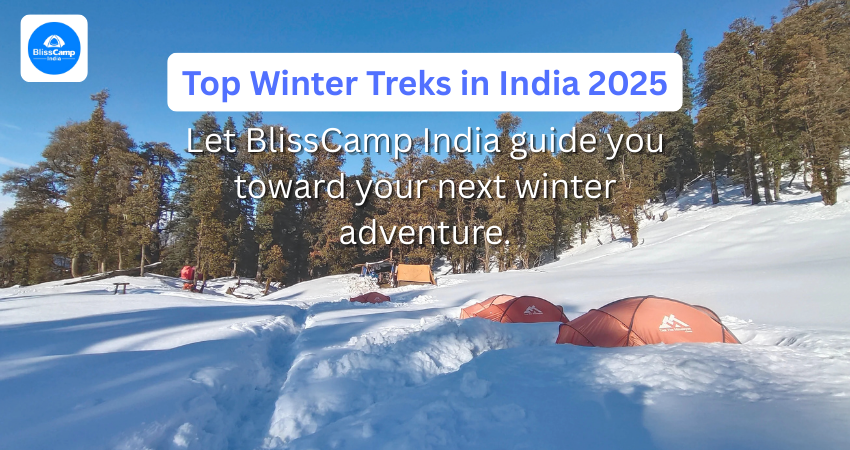
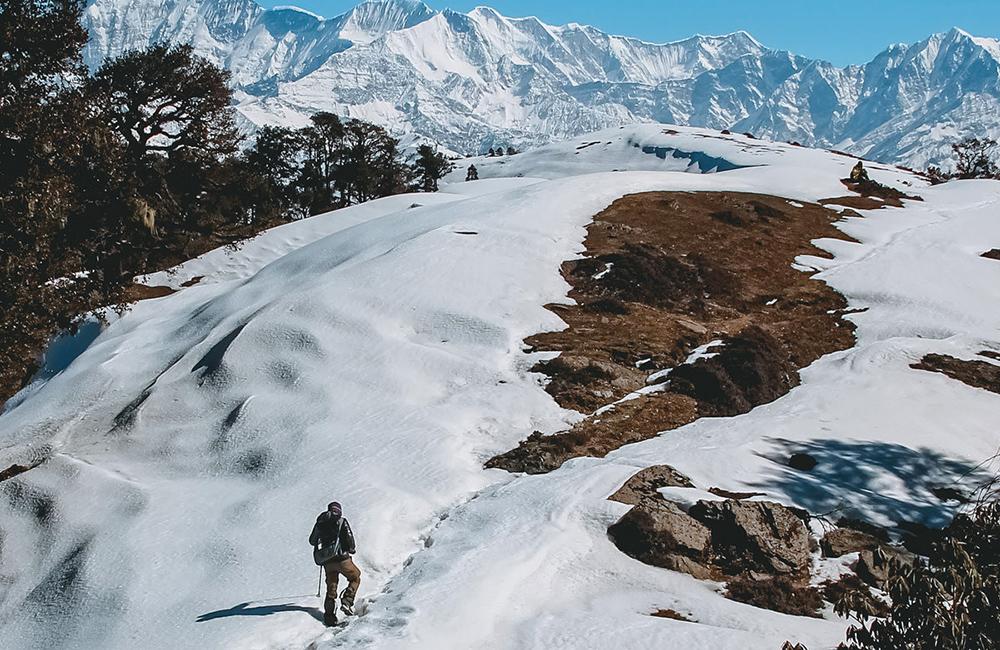

[…] of trekkers each year. From Kedarkantha to Har Ki Dun, these trails are considered among the best winter treks in India. Adventurers looking for the best treks should always consider their stamina and readiness before […]